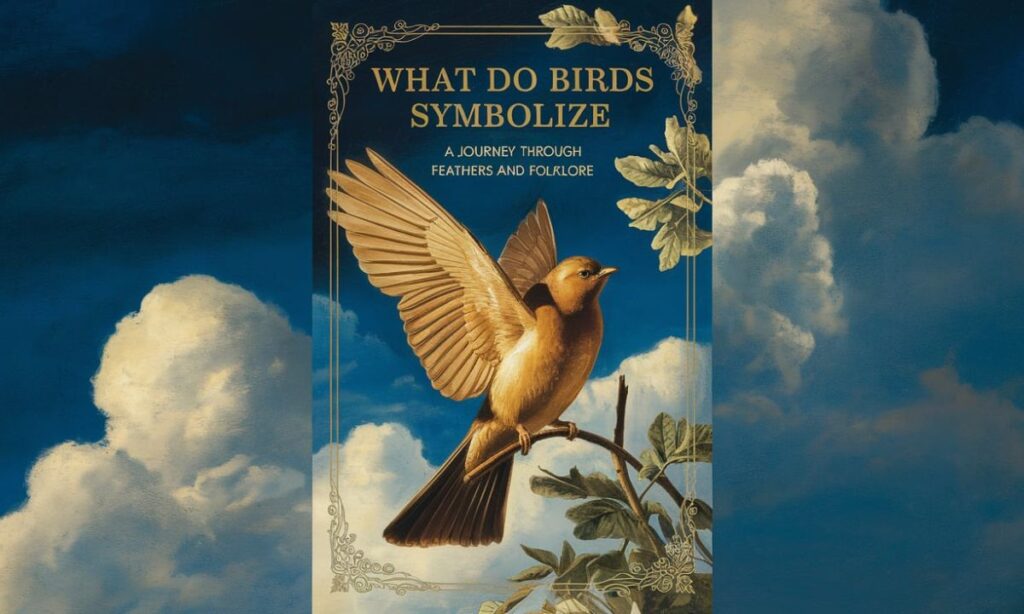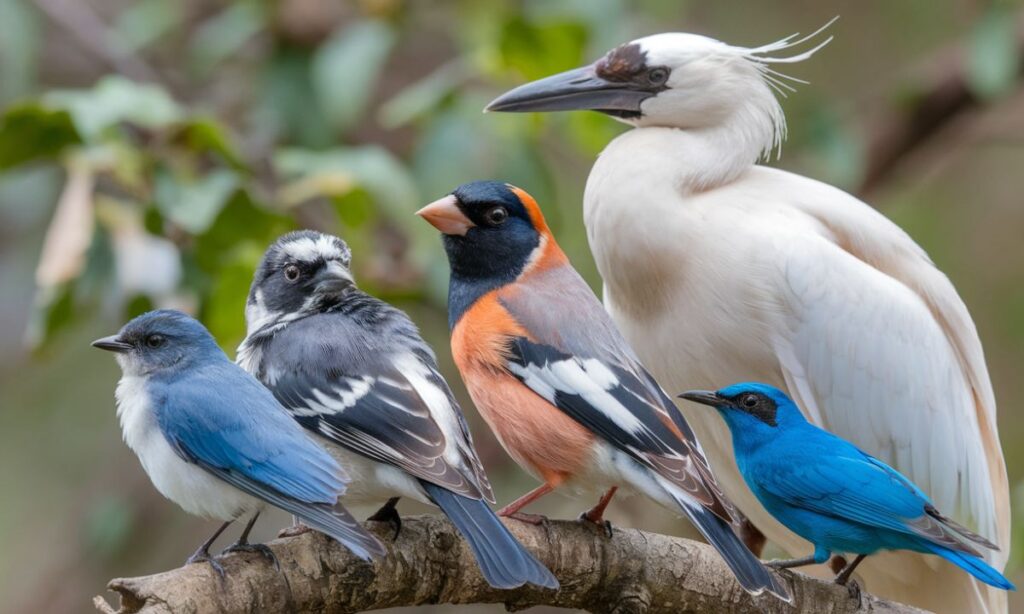Birds have captivated human imagination for millennia, soaring through our myths, art, and daily lives with grace and mystery. From the majestic eagle to the humble sparrow, these winged wonders carry a wealth of symbolism that varies across cultures and time.
Let’s embark on a fascinating exploration of what birds symbolize, diving into the rich tapestry of avian meanings that color our world.
An Overview of Global Bird Symbolism
Birds are universal symbols, their presence in the sky connecting cultures across the globe. They often represent:
- Freedom and aspiration
- The human soul or spirit
- Messengers between earth and sky
- Omens of good or bad fortune
- Wisdom and knowledge
The way we interpret birds can tell us a lot about our own values and beliefs. For instance, while an eagle might symbolize power and freedom in one culture, it could represent aggression in another.
“A bird doesn’t sing because it has an answer, it sings because it has a song.” – Maya Angelou
This quote beautifully captures the essence of why birds resonate so deeply with us. Their symbolism isn’t always about concrete meanings, but about the emotions and ideas they evoke.
Birds’ ability to fly has long fascinated humans, leading to their association with transcendence and spiritual journeys. In many cultures, birds are seen as intermediaries between the earthly and divine realms, carrying messages or prayers to the heavens.
Birds and Their Symbolism in North America
In North America, bird symbolism blends Native American traditions with more recent cultural interpretations. Let’s look at a few key examples:
- Bald Eagle: The national bird of the United States, symbolizing freedom, strength, and courage. Its image appears on the Great Seal of the United States and various official documents.
- Turkey: Benjamin Franklin’s preferred choice for the national bird, representing abundance and sacrifice. While it didn’t become the national symbol, the turkey remains an important part of American culture, particularly during Thanksgiving celebrations.
- Blue Jay: Often seen as a symbol of intelligence and communication. Its bold and noisy nature has led to associations with fearlessness and determination.
- Cardinal: Believed by many to be a spiritual messenger, especially from deceased loved ones. Its bright red plumage makes it stand out, reinforcing its perceived role as a messenger.
- Raven: In many Native American traditions, the raven is seen as a trickster figure, but also a creator and transformer of the world.
Native American cultures have particularly rich traditions of bird symbolism. For instance, the Thunderbird is a legendary creature in many tribes, symbolizing power and protection. It’s believed to create thunder by flapping its wings and lightning by blinking its eyes.
The use of eagle feathers in Native American ceremonies highlights the spiritual significance of birds. These feathers are considered sacred and are often used in important rituals, prayer fans, and headdresses.
Bird Symbolism in Ancient Egypt
Ancient Egyptians held birds in high regard, incorporating them into their complex mythology and hieroglyphic writing system. Some notable examples include:
- Horus: The falcon-headed god, symbolizing kingship and the sky. Horus was one of the most important deities in the Egyptian pantheon, often associated with the Pharaohs.
- Thoth: The ibis-headed god of wisdom and writing. Thoth was believed to have invented hieroglyphs and was often depicted recording the results of the weighing of the heart ceremony in the afterlife.
- Ba: The human-headed bird representing the soul of the deceased. The Ba was believed to be able to leave the tomb and revisit the world of the living.
- Bennu: A heron-like bird associated with creation and rebirth, often seen as a precursor to the Greek phoenix.
Birds were so important in ancient Egyptian culture that they were often mummified and buried with pharaohs to guide them in the afterlife. Archaeologists have discovered millions of mummified birds in Egyptian tombs, highlighting their spiritual significance.
The Egyptian hieroglyphic system also incorporated numerous bird symbols, each with its own meaning. For example, the owl hieroglyph represented the sound “m”, while also carrying connotations of wisdom and night.
Bird Symbolism in Native American Cultures
Native American cultures have a profound connection with nature, and birds play a significant role in their spiritual beliefs and practices. Here’s a brief overview:
| Bird | Symbolism |
| Eagle | Spiritual power, wisdom, connection to the Creator |
| Raven | Creation, transformation, knowledge |
| Hummingbird | Joy, love, beauty, intelligence |
| Owl | Wisdom, foresight, keeper of sacred knowledge |
| Hawk | Messenger, intuition, victory |
| Turkey | Abundance, fertility, blessing |
Feathers, particularly eagle feathers, are often used in important ceremonies and rituals, symbolizing a connection to the spiritual realm. In many tribes, finding a feather is considered a gift from the spirit world and is treated with great respect.
The Pueblo peoples of the Southwestern United States have a particularly strong tradition of bird symbolism in their art and ceremonies. Their famous pottery often features bird motifs, each with its own meaning and significance.
Birds in Chinese Culture
In Chinese culture, birds are often associated with good fortune and positive omens. Some notable examples include:
- Crane: Longevity and wisdom. The crane is one of the most revered birds in Chinese culture, often depicted in art alongside pine trees and stones to symbolize a long and happy life.
- Phoenix: Rebirth and feminine power. The phoenix, or Fenghuang, is often paired with the dragon to represent the balance between yin and yang.
- Magpie: Joy and marital bliss. In Chinese folklore, magpies are known as “birds of joy” and are believed to bring good news.
- Mandarin Duck: Fidelity and happy marriages. These ducks are often given as wedding gifts due to their reputation for mating for life.
- Rooster: Punctuality and good fortune. The rooster is one of the twelve animals of the Chinese zodiac and is associated with warding off evil spirits.
These symbols appear frequently in Chinese art, literature, and even everyday objects like decorative plates or clothing patterns. Bird motifs are particularly common in traditional Chinese paintings, where they often represent specific virtues or ideas depending on how they’re depicted.
In feng shui, the ancient Chinese practice of harmonizing individuals with their surrounding environment, birds and bird imagery are used to attract positive energy. For example, paintings of birds in flight are believed to bring opportunities and good luck to a home or office.
Bird Symbolism in Celtic and Norse Mythology

Celtic and Norse mythologies are rich with avian symbolism. Ravens and crows, in particular, play significant roles:
- In Norse mythology, Odin’s ravens Huginn and Muninn represent thought and memory. These birds fly around the world each day, bringing information back to Odin.
- In Celtic lore, the goddess Morrigan often takes the form of a crow, symbolizing war and fate. The appearance of crows on a battlefield was seen as her presence.
Other birds, like swans and eagles, also feature prominently in these mythologies, often representing transformation or divine power.
- The swan in Celtic mythology is associated with love and purity. In some stories, gods or heroes transform into swans.
- The eagle in Norse mythology is associated with wisdom and is said to sit atop Yggdrasil, the world tree.
These mythological birds often possess supernatural abilities, such as prophecy or shape-shifting, further emphasizing their connection to the divine and mystical realms.
Birds in African Culture
Across the diverse cultures of Africa, birds hold various symbolic meanings:
- The Sankofa bird in West African Adinkra symbolism represents the importance of learning from the past. This mythical bird flies forward while looking backward, carrying an egg in its mouth.
- In many African folktales, birds are clever tricksters or wise advisors. The Zulu people, for instance, have stories about a wise bird that gives advice to humans.
- The Marabou stork is often associated with ugliness and bad luck in some cultures, while in others it’s seen as a symbol of wisdom due to its appearance of deep thought when standing still.
- The Egyptian Plover, also known as the Crocodile Bird, is the subject of a famous symbiotic relationship story, where it’s said to clean crocodiles’ teeth. This relationship has come to symbolize unlikely friendships and mutual benefit.
In many African cultures, birds are also seen as messengers between the physical and spiritual worlds, similar to beliefs in other parts of the world.
The Wings of Hope
Birds often symbolize hope across different cultures, embodying the human desire for freedom and transcendence. Let’s explore some specific examples:
The Dove
Perhaps the most universal symbol of peace, the dove has roots in biblical stories and has been adopted by peace movements worldwide. Its gentle nature and white color contribute to its association with purity and hope.
In the story of Noah’s Ark, a dove returning with an olive branch signaled the end of the flood, cementing its status as a symbol of hope and new beginnings. This symbolism has persisted through centuries, with doves being released at weddings, funerals, and peace ceremonies around the world.
The Red Cardinal
In North American folklore, the cardinal is often seen as a spiritual messenger. Many people believe that when a cardinal appears, it’s a sign from a deceased loved one. This belief brings comfort and hope to many.
The bright red color of the cardinal, standing out against winter snow, has also led to its association with vitality, warmth, and perseverance through difficult times.
The Blue Jay
Known for its intelligence and vibrant color, the blue jay is often associated with clarity and communication. Its bold nature can symbolize the courage to speak one’s truth.
In some Native American traditions, the blue jay is seen as a trickster figure, but also as a symbol of faithfulness and solidarity due to its strong bond with its mate.
The Sparrow
Despite its small size, the sparrow carries potent symbolism. In many cultures, it represents:
- Triumph over adversity
- The power of community
- Simplicity and hard work
In ancient Greek mythology, sparrows were associated with Aphrodite, the goddess of love, symbolizing the power of small things and the importance of love.
The Crane
In Asian cultures, particularly Japan, the crane symbolizes:
- Longevity
- Good fortune
- Fidelity
The tradition of folding 1000 paper cranes for good luck or healing is a testament to the crane’s powerful symbolism. This practice gained worldwide recognition through the story of Sadako Sasaki, a young victim of the Hiroshima bombing who folded cranes while hospitalized.
The Penguin
While not traditionally associated with flight, penguins symbolize:
- Adaptability
- Community and social bonds
- Resilience in harsh conditions
Their ability to thrive in some of the world’s most challenging environments makes them powerful symbols of hope and perseverance. The way penguins huddle together for warmth has also made them symbols of unity and mutual support.
Bird symbolism: 10 common birds and their spiritual meaning

Let’s dive deeper into the symbolism of some common birds:
- Sparrow: Joy, protection, simplicity. In many cultures, sparrows are seen as industrious and vigilant, teaching us the value of hard work and community.
- Eagle: Power, freedom, spiritual protection. The eagle’s keen vision has led to its association with foresight and strategic thinking in many cultures.
- Crane: Longevity, balance, wisdom. In Japan, the crane is said to live for a thousand years and is a popular subject in art and origami.
- Blue jay: Communication, intelligence, curiosity. The blue jay’s bold and noisy nature has led to its association with fearlessness and determination.
- Heron: Patience, self-reliance, grace. The heron’s ability to stand still for long periods while hunting has made it a symbol of meditation and focus.
- Nightingale: Love, creativity, voice. The nightingale’s beautiful song has inspired poets and writers for centuries, making it a symbol of artistic expression.
- Robin: New beginnings, growth, renewal. The robin’s appearance in spring has led to its association with new starts and fresh opportunities.
- Cardinal: Vitality, responsibility, faith. The cardinal’s bright red color and its year-round presence have made it a symbol of living life to the fullest.
- Woodpecker: Opportunity, rhythm, home. The woodpecker’s persistent drumming has led to its association with determination and the power of steady effort.
- Albatross: Freedom, endurance, navigation. Sailors once believed that albatrosses carried the souls of dead sailors, giving them a mystical significance.
Each of these birds carries a rich tapestry of meanings that can vary across cultures and contexts. Their symbolism often derives from their physical characteristics, behaviors, or the roles they play in various ecosystems.
Common elements of bird symbolism
Despite the diversity of bird symbolism, some common threads emerge:
- Flight: Often symbolizes freedom, transcendence, or connection to the divine. The ability to fly has long fascinated humans, leading to birds being associated with our aspirations and dreams.
- Song: Can represent joy, communication, or the human soul. Bird songs have inspired countless poets and musicians, symbolizing the beauty of self-expression.
- Plumage: Bright colors often symbolize vitality or spiritual enlightenment. The variety of bird plumage has led to different species being associated with different qualities or emotions.
- Behavior: Migratory patterns, mating habits, and other behaviors inform symbolic meanings. For example, birds that mate for life are often seen as symbols of fidelity and commitment.
Understanding these common elements can help us interpret bird symbolism across different contexts. It’s important to remember that symbolism can vary greatly between cultures and even individuals, based on personal experiences and cultural background.
What Do Birds Symbolize In Art?
Birds have been a popular subject in art throughout history, from ancient cave paintings to modern sculpture. In art, birds often symbolize:
- Freedom: The ability to transcend earthly constraints
- The soul: Particularly in religious and spiritual art
- Nature’s beauty: Celebrating the diversity and wonder of the natural world
- Human emotions: Different birds can represent various emotional states
Famous artists like John James Audubon have dedicated their careers to capturing the beauty and symbolism of birds in their work. Audubon’s detailed illustrations in “The Birds of America” not only served as important scientific documentation but also elevated bird art to new heights.
In modern art, birds continue to be a source of inspiration. For example, Brancusi’s sculpture “Bird in Space” abstracts the essence of flight into a sleek, streamlined form, representing the idea of freedom and transcendence.
Ancient Birds
In ancient art and mythology, birds often held divine or mystical significance:
- The Egyptian god Horus was depicted with a falcon’s head, symbolizing divine kingship
- The Greek myth of Icarus features artificial wings, representing human ambition and its potential pitfalls
- In Mayan art, birds were often associated with deities and the heavens, serving as messengers between worlds
These ancient depictions have influenced how we perceive and symbolize birds today. The concept of birds as messengers between earth and sky, for instance, persists in many modern spiritual beliefs.
Symbolism In Art
Let’s look at some famous artworks featuring birds and their symbolic meanings:
- “The Goldfinch” by Carel Fabritius: The chained goldfinch symbolizes the fragility of life and freedom. This small painting has inspired a Pulitzer Prize-winning novel and subsequent film adaptation.
- “The Garden of Earthly Delights” by Hieronymus Bosch: Features numerous birds, often symbolizing human souls or desires. The complex symbolism in this triptych has been the subject of much scholarly debate.
- “The Wounded Deer” by Frida Kahlo: Includes a stag with antlers full of branches and birds, symbolizing Kahlo’s own suffering and resilience. This self-portrait combines human and animal forms to express complex emotions.
- “The Hunters in the Snow” by Pieter Bruegel the Elder: Features birds as small but significant elements, representing the cycles of nature and human activity.
These artworks demonstrate how birds can be used to convey complex emotions and ideas in visual form. They also show how bird symbolism can be integrated into larger artistic narratives and concepts.
Avian Art Symbolism Today
Contemporary artists continue to use bird symbolism in innovative ways:
- Street artist Banksy has used birds in several works to symbolize freedom and escape from societal constraints. His piece “Girl with Balloon” features a girl reaching for a heart-shaped balloon, which could be interpreted as a bird-like symbol of hope and aspiration.
- Sculptor Cedric Laquieze creates fantastical bird-human hybrids, exploring themes of transformation and the blurring of natural boundaries. His work challenges our perceptions of the divide between human and animal.
- Photographer Tim Flach’s detailed bird portraits challenge viewers to see the individuality and emotion in avian subjects. His work encourages us to reconsider our relationship with the natural world.
- Installation artist Cai Guo-Qiang has created dramatic works featuring flocks of birds, often using gunpowder as a medium. His piece “Heritage” features 99 life-sized replicas of animals gathered around a blue waterhole, including several bird species, symbolizing a utopian gathering of all of Earth’s creatures.
These modern interpretations build on traditional symbolism while adding new layers of meaning for contemporary audiences. They often address current issues like environmentalism, urbanization, and the relationship between humans and nature.
The Science Behind Bird Symbolism
While much of bird symbolism is rooted in culture and tradition, there are also scientific reasons why certain birds have come to represent particular ideas:
- Ravens and crows, often associated with intelligence in folklore, have been shown in scientific studies to possess problem-solving skills on par with great apes.
- The homing ability of pigeons, which has led to their use as messengers throughout history, is now understood to be based on their sensitivity to the Earth’s magnetic fields.
- The dawn chorus of songbirds, often symbolizing renewal and hope, is actually a complex behavior related to territory defense and mate attraction.
Understanding the science behind bird behavior can enrich our appreciation of their symbolic meanings and help us forge deeper connections with the natural world.
Birds in Literature
Birds have been powerful symbols in literature across cultures and throughout history. Here are a few notable examples:
- In Edgar Allan Poe’s poem “The Raven,” the bird symbolizes grief, loss, and the supernatural.
- Maya Angelou’s autobiography “I Know Why the Caged Bird Sings” uses the metaphor of a caged bird to represent the struggle against racial and social oppression.
- In “To Kill a Mockingbird” by Harper Lee, the mockingbird symbolizes innocence and the injustice of harming vulnerable beings.
“Hope is the thing with feathers / That perches in the soul” – Emily Dickinson
This famous line from Dickinson’s poem beautifully encapsulates the enduring association between birds and hope in literature.
Birds in Popular Culture
Bird symbolism has permeated popular culture in various ways:
- Social media platform Twitter uses a bird logo, symbolizing the quick, concise nature of its communication format.
- Sports teams often use bird mascots to represent speed, power, or local wildlife (e.g., the Philadelphia Eagles, Baltimore Ravens).
- In the Harry Potter series, different bird species are associated with different character traits: owls with wisdom, phoenixes with rebirth and loyalty.
These examples show how traditional bird symbolism has been adapted and reinterpreted in modern contexts.
Final Thoughts
The symbolism of birds is as vast and varied as the species themselves. From the mighty eagle to the tiny hummingbird, each carries its own set of meanings shaped by culture, mythology, and personal experience. As we’ve seen, birds can represent everything from divine messengers to symbols of the human soul, from harbingers of fortune to embodiments of natural beauty.
In our modern world, where we’re often disconnected from nature, the enduring symbolism of birds serves as a powerful reminder of our connection to the natural world. Whether we’re watching a robin in our backyard or admiring a crane in a piece of artwork, birds continue to captivate our imagination and speak to something deep within us.
So the next time you hear a bird song or spot a feathered friend, take a moment to reflect on what it might symbolize. You might just find a message of hope, a spark of inspiration, or a moment of connection with the vast tapestry of human culture and natural wonder that surrounds us.
Remember, the symbolism of birds is not set in stone. It’s a living, evolving language that we all contribute to. What do birds symbolize to you?
FAQ’s
What is the spiritual meaning of birds?
Birds often represent spiritual freedom, transcendence, and connection to the divine. They’re seen as messengers between the earthly and spiritual realms in many cultures.
What are birds a metaphor for?
Birds are commonly metaphors for freedom, the human soul, aspiration, and transcendence of earthly constraints.
What does it mean when a bird visits you?
A bird’s visit is often interpreted as a message from the spiritual world, a sign of good fortune, or a reminder to pay attention to something in your life.
Are birds a good omen?
Many cultures consider birds to be good omens, symbolizing hope, renewal, and positive change. However, the interpretation can vary depending on the species and context.
What does a bird symbolize?
Birds generally symbolize freedom, the soul, and connection to the divine. Specific meanings can vary widely based on the species and cultural context.
What do birds symbolize in the Bible?
In the Bible, birds often symbolize God’s presence, divine providence, and the Holy Spirit. The dove, for instance, represents peace and the Holy Spirit.
What do birds symbolize in culture?
Across cultures, birds symbolize various concepts including freedom, the soul, wisdom, and communication between the earthly and spiritual realms.
What do birds symbolize in art?
In art, birds often represent freedom, the soul, nature’s beauty, and human emotions. They can also symbolize specific virtues or ideas depending on the artist’s intent.
What do birds symbolize in love?
In love symbolism, birds often represent devotion, especially species that mate for life. They can also symbolize the freedom and joy associated with love.
What bird has a partner for life?
Several bird species mate for life, including swans, geese, albatrosses, penguins, and many types of parrots.
Which bird is a symbol of good luck and new life?
The stork is often seen as a symbol of good luck and new life, particularly in Western cultures where it’s associated with delivering babies. In many Asian cultures, the crane symbolizes longevity and good fortune.
Also Read : FintechZoom Costco Stock: In-Depth Analysis & More










